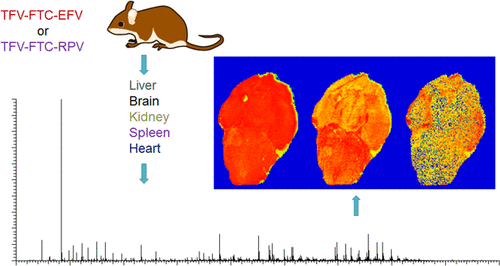当前位置:
X-MOL 学术
›
ACS Pharmacol. Transl. Sci.
›
论文详情
Our official English website, www.x-mol.net, welcomes your
feedback! (Note: you will need to create a separate account there.)
Spatial Distribution Profiles of Emtricitabine, Tenofovir, Efavirenz, and Rilpivirine in Murine Tissues Following In Vivo Dosing Correlate with Their Safety Profiles in Humans.
ACS Pharmacology & Translational Science ( IF 4.9 ) Pub Date : 2020-04-23 , DOI: 10.1021/acsptsci.0c00015 Herana Kamal Seneviratne 1 , Allyson N Hamlin 1 , Carley J S Heck 1 , Namandjé N Bumpus 1
ACS Pharmacology & Translational Science ( IF 4.9 ) Pub Date : 2020-04-23 , DOI: 10.1021/acsptsci.0c00015 Herana Kamal Seneviratne 1 , Allyson N Hamlin 1 , Carley J S Heck 1 , Namandjé N Bumpus 1
Affiliation

|
Emtricitabine (FTC), tenofovir (TFV), efavirenz (EFV), and rilpivirine (RPV) are currently used as components of HIV combination therapy. Although these drugs are widely used in antiretroviral therapy, several organ toxicities related to TFV and EFV have been observed clinically. TFV is associated with nephrotoxicity, whereas EFV-related hepatotoxicity and neurotoxicity have been reported. While the precise molecular mechanisms related to the above-mentioned clinically observed toxicities have yet to be elucidated, understanding the local tissue distribution profiles of these drugs could yield insights into their safety profiles. To date, the distributions of these drugs in tissue following in vivo exposure are poorly understood. Therefore, in this study, we employed a matrix-assisted laser desorption/ionization mass spectrometry imaging method to generate spatial distribution profiles of FTC, TFV, EFV, and RPV in mouse tissues following in vivo dosing of following drug regimens: TFV–FTC–EFV and TFV–FTC–RPV. For this study, liver, brain, kidney, spleen, and heart tissues were obtained from mice (n = 3) following separate oral administration of the above-mentioned drug regimens. Interestingly, EFV was detected in liver, brain, and heart following TFV–FTC–EFV treatment. Additionally, hydroxylated EFV, which encompasses the cytochrome P450-dependent monooxygenated metabolites of EFV, was detected in liver, brain, spleen, and heart tissue sections. Notably, the tissue distribution profiles of RPV and hydroxylated RPV following in vivo dosing of TFV–FTC–RPV were different from EFV/hydroxylated EFV despite RPV belonging to the same drug class as EFV. In conclusion, the observed spatial distribution profiles of the study drugs are in agreement with their safety profiles in humans.
中文翻译:

体内给药后恩曲他滨,替诺福韦,依法韦仑和利吡韦林在小鼠组织中的空间分布特征与它们在人体中的安全性特征相关。
恩曲他滨(FTC),替诺福韦(TFV),依非韦伦(EFV)和利比韦林(RPV)目前被用作HIV联合疗法的组成部分。尽管这些药物广泛用于抗逆转录病毒治疗,但临床上已观察到与TFV和EFV相关的几种器官毒性。TFV与肾毒性有关,而EFV相关的肝毒性和神经毒性已有报道。尽管尚未阐明与上述临床观察到的毒性有关的确切分子机制,但了解这些药物的局部组织分布状况可能有助于深入了解其安全性。迄今为止,这些药物在体内的组织分布接触了解甚少。因此,在这项研究中,我们采用体内辅助的以下药物方案,通过矩阵辅助激光解吸/电离质谱成像方法在小鼠组织中生成FTC,TFV,EFV和RPV的空间分布图: EFV和TFV–FTC–RPV。在本研究中,从小鼠获得肝,脑,肾,脾和心脏组织(n= 3)在上述药物方案的单独口服给药之后。有趣的是,在TFV–FTC–EFV治疗后,在肝,脑和心脏中检测到EFV。此外,在肝,脑,脾和心脏组织切片中检测到羟基化的EFV,其中包括EFV依赖于细胞色素P450的单加氧代谢产物。值得注意的是,尽管RPV与EFV属于同一药物类别,但在体内给予TFV–FTC–RPV后RPV和羟基化RPV的组织分布特征与EFV /羟基化EFV不同。总之,观察到的研究药物的空间分布特征与其在人体中的安全性特征相符。
更新日期:2020-04-23
中文翻译:

体内给药后恩曲他滨,替诺福韦,依法韦仑和利吡韦林在小鼠组织中的空间分布特征与它们在人体中的安全性特征相关。
恩曲他滨(FTC),替诺福韦(TFV),依非韦伦(EFV)和利比韦林(RPV)目前被用作HIV联合疗法的组成部分。尽管这些药物广泛用于抗逆转录病毒治疗,但临床上已观察到与TFV和EFV相关的几种器官毒性。TFV与肾毒性有关,而EFV相关的肝毒性和神经毒性已有报道。尽管尚未阐明与上述临床观察到的毒性有关的确切分子机制,但了解这些药物的局部组织分布状况可能有助于深入了解其安全性。迄今为止,这些药物在体内的组织分布接触了解甚少。因此,在这项研究中,我们采用体内辅助的以下药物方案,通过矩阵辅助激光解吸/电离质谱成像方法在小鼠组织中生成FTC,TFV,EFV和RPV的空间分布图: EFV和TFV–FTC–RPV。在本研究中,从小鼠获得肝,脑,肾,脾和心脏组织(n= 3)在上述药物方案的单独口服给药之后。有趣的是,在TFV–FTC–EFV治疗后,在肝,脑和心脏中检测到EFV。此外,在肝,脑,脾和心脏组织切片中检测到羟基化的EFV,其中包括EFV依赖于细胞色素P450的单加氧代谢产物。值得注意的是,尽管RPV与EFV属于同一药物类别,但在体内给予TFV–FTC–RPV后RPV和羟基化RPV的组织分布特征与EFV /羟基化EFV不同。总之,观察到的研究药物的空间分布特征与其在人体中的安全性特征相符。











































 京公网安备 11010802027423号
京公网安备 11010802027423号